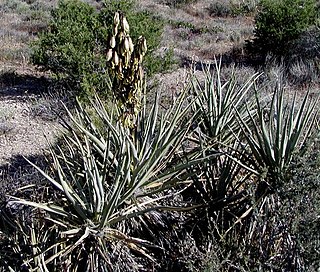
Yucca baccata is a common species of yucca native to the deserts of the southwestern United States and northwestern Mexico, from southeastern California north to Utah, east to western Texas and south to Sonora and Chihuahua. It is also reported in the wild in Colombia.
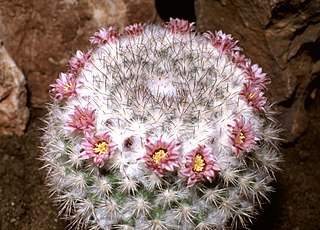
Mammillaria is one of the largest genera in the cactus family (Cactaceae), with currently 200 known species and varieties recognized. Most of the mammillaria are native to Mexico, but some come from the southwest United States, the Caribbean, Colombia, Venezuela, Guatemala and Honduras. The common name "pincushion cactus" refers to this and the closely related genus Escobaria.

Pediocactus is a genus of cacti. The genus comprises between 6 and 11 species, depending upon the authority. Species of this genus are referred to as hedgehog cacti, though that name is also applied to plants from the genera Echinocereus and Echinopsis. Species may also be referred to as pincushion cacti, a common name which is also applied to other genera.

Pediocactus bradyi subsp. winkleri, commonly known as Winkler's cactus or Winkler's pincushion cactus, is a small cactus endemic to the state of Utah in the United States. It is known only from Emery and Wayne Counties.
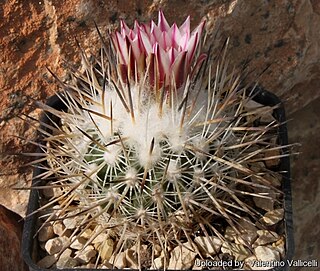
Rapicactus mandragora, synonym Turbinicarpus mandragora, is a species of plant in the family Cactaceae.

Pelecyphora vivipara is a species of cactus known by several common names, including spinystar, viviparous foxtail cactus, pincushion cactus and ball cactus. It is native to North America, where certain varieties can be found from Mexico to Canada. Most of these varieties are limited to the Mojave and Sonoran Deserts. The species epithet "vivipara" is due to the species' viviparous reproductive habit.
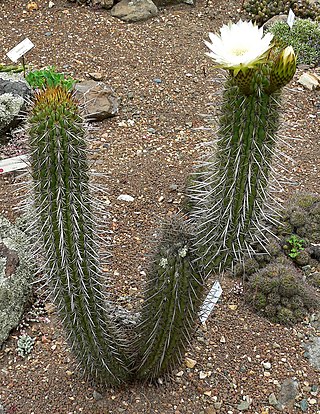
Leucostele chiloensis is a species of cactus native to South America; genus members are known as hedgehog cacti, sea-urchin cactus or Easter lily cactus.

Cylindropuntia echinocarpa is a species of cactus known by the common names silver cholla, golden cholla, and Wiggins' cholla. It was formerly named Opuntia echinocarpa.

Escobaria robbinsorum is a rare species of cactus known by the common names Cochise pincushion cactus and Cochise foxtail cactus. It is native to southern Arizona in the United States, where it is known only from Cochise County, and northern Sonora in Mexico. There are scattered small occurrences on the north side of the border, and one known population to the south. Because of its rarity and a number of threats to remaining plants, the species was federally listed with a threatened status in 1986.

Pelecyphora sneedii is a rare species of cactus known by the common names Sneed's pincushion cactus and carpet foxtail cactus.

Echinocereus viridiflorus is a species of cactus known by the common names nylon hedgehog cactus, green pitaya, and small-flowered hedgehog cactus. It is native to the central and south-central United States and northern Mexico, where it can be found in varied habitat types, including desert scrub, woodlands, dry grasslands, and short-grass prairie.

Pediocactus sileri is a rare species of cactus known by the common names Siler's pincushion cactus and gypsum cactus. It is native to southwestern Utah and northwestern Arizona in the United States. It is limited to a specific type of soil, individuals are often spaced far apart, and the species is threatened by a number of human activities such as off-road vehicle use, poaching, and uranium mining. This is a federally listed threatened species of the United States.

Pediocactus bradyi is a very rare species of cactus known by the common names Brady's pincushion cactus, Brady's hedgehog cactus, and Marble Canyon cactus. It is endemic to Arizona in the US, where it is restricted to Marble Canyon in Coconino County, though its exact distribution is not generally advertised due to poaching concerns. It is limited to a specific type of soil, it has a small distribution, and the species is threatened by a number of human activities. This has been a federally listed endangered species of the United States since 1979.

Pediocactus despainii is a rare species of cactus known by the common names Despain's cactus and San Rafael cactus.

Pediocactus knowltonii is a rare species of cactus known by the common names Knowlton's miniature cactus, Knowlton's pincushion cactus, and Knowlton's minute cactus.

Pachycereus pecten-aboriginum is a columnar cactus plant native to Mexico. They can grow up to 15 m (49 ft) high. The trunk of this species is 1.2 to 5.0 m tall and the fruits are large and burr-like. The specific name, pecten-aboriginum, is from the Latin, and means "native combs". It was inspired by the use of the fruits as hair combs.

Sclerocactus sileri, the Siler fishhook cactus, is a rare and very small cactus found mostly in mineral-rich desert areas of intermediate elevations, notably in the American states of Utah, Nevada, and northern Arizona.

Coryphantha robustispina, the Pima pineapple cactus, is a federally protected cactus of the Sonoran Desert. It is commonly found in Pima County, Arizona although it is also found throughout New Mexico and as far east as Texas.

Pediocactus nigrispinus is a species in the cactus family with the common names snowball cactus, Columbia Plateau cactus, and basalt cactus. It is found in dry areas in Washington, Oregon, and Idaho.
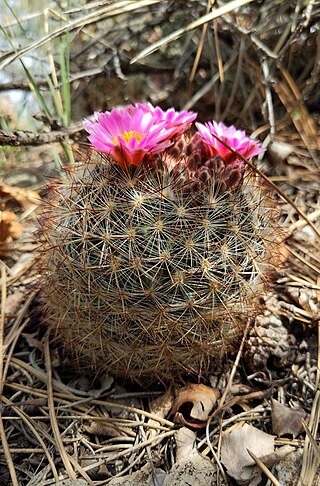
Pediocactus simpsonii, known by the common names mountain cactus, snowball cactus, and mountain ball cactus, is a relatively common cactus that has adapted to survive in cold and dry environments in high elevation areas of the western United States. It can be found at higher elevations than any other cactus in North America. While not a landscape dominating plant, it is a relatively common species and the most common member of the genus Pediocactus. Because of its beauty and adaptation to cold environments it is sometimes grown by gardeners in areas that have few other choices due to the limited number of cactuses with cold adaptations. Like many cactuses its populations are sometimes threatened by this desirability due to the theft or removal of plants from the wild by collectors.





















